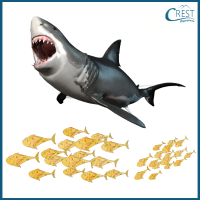1. Rainforests are characterised by their hot and humid climate, along with abundant rainfall throughout the year. Which of the following adaptations is specific to plants in the tropical rainforest?
a) Salt tolerance
b) Drip tips on leaves to prevent rotting
c) Reduced root size for water absorption
d) Long and narrow stems to withstand water current
Answer: b) In the tropical rainforest, where heavy rainfall is common, plants have adapted to deal with the excess moisture. Drip tips on leaves allow rainwater to run off quickly, preventing water from pooling and reducing the risk of infections that could cause rotting.
2. Consider the following statements and choose the correct option.
Statement I: Polar bears have a layer of fat and thick fur to survive in cold Arctic environments.
Statement II: Cacti have shallow roots that spread widely to quickly absorb water in desert habitats.
a) Statement I is correct but statement II is incorrect.
b) Statement I is incorrect but statement II is correct.
c) Both statements are correct.
d) Both statements are incorrect.
Answer:a) Statement I is correct but statement II is incorrect.
Polar bears have a layer of fat and thick fur to help them stay warm in the cold Arctic environment. However, cacti actually have deep roots that go down into the ground to access water sources in desert habitats, rather than shallow roots that spread widely. This adaptation helps cacti survive in dry environments by reaching deeper water reserves.
3. What is the main purpose of a streamlined body shape in aquatic animals shown below?

a) To reduce resistance and swim faster
b) To camouflage in the water
c) To store extra fat for insulation
d) To extract oxygen from the water
Answer: a) The main purpose of a streamlined body shape in aquatic animals, such as sharks and fish, is to reduce resistance and swim faster through the water. The streamlined help these animals to move efficiently and swiftly in their aquatic environment.
4. Examine the following characteristics:
i) Waterproof feathers and webbed feet
ii) Thick layer of fat and fur
iii) Adaptations for swimming in cold water
In which of the following regions do we find animals with these adaptations?
a) Desert
b) Tundra
c) Coastal areas
d) Grasslands
Answer: b) The characteristics mentioned are typically found in animals that inhabit the tundra region. The tundra is a cold and often snowy environment, and animals like Arctic birds and mammals, such as polar bears and Arctic foxes, have evolved these adaptations to survive in the harsh conditions of the tundra, including swimming in icy waters and staying warm in extremely low temperatures.
5. Match the following habitats with their corresponding characteristics.
|
Column I
|
Column II
|
|
1. Desert
|
A) Hot and humid with heavy rainfall
|
|
2. Grassland
|
B) Cold and dry with sparse vegetation
|
|
3. Rainforest
|
C) Arid with high temperatures and low rainfall
|
|
4. Tundra
|
D) Flat and treeless with tall grasses
|
a) 1:A, 2:B, 3:C, 4:D
b) 1:D, 2:C, 3:B, 4:A
c) 1:C, 2:D, 3:A, 4:B
d) 1:A, 2:D, 3:C, 4:B
Answer: c) Deserts are characterised as arid habitats with high temperatures and low rainfall.
Grasslands are flat and treeless habitats with tall grasses.
Rainforests are hot and humid habitats with heavy rainfall.
Tundra habitats are cold and dry with sparse vegetation.


